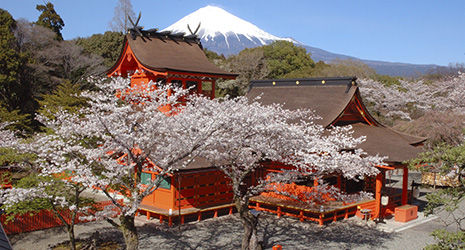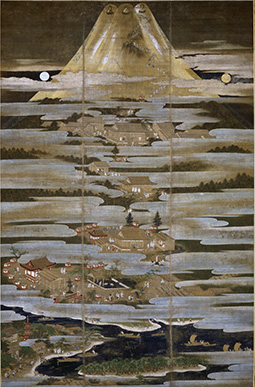Home > Highlighting JAPAN > Highlighting Japan August 2019 > In Praise of Mountains
Highlighting JAPAN


Mount Fuji, Object of Faith
Mount Fuji is a symbol of Japan and, at 3,776 meters, Japan’s highest peak. In 2013, Mount Fuji was afforded World Heritage status as a “cultural” heritage site. The mountain has been depicted in art and literature since ancient times, and holds special meaning for those people who have been drawn to it as an object of faith.
Mount Fuji is Japan’s highest mountain, a magnificent isolated peak whose foothills gradually descend, on the southern side, into Suruga Bay. Its beautiful conical shape can be seen from far away and from any direction over an area of some 2,800 square kilometers. Mount Fuji features in many poems in the Man’yoshu, Japan’s oldest collection of poetry, and is the motif of the “Thirty-six Views of Mount Fuji” woodblock print series by Katsushika Hokusai. Moreover, Mount Fuji has come to hold special meaning as an object of faith for the Japanese people since ancient times.
The central tenet of the Mount Fuji faith is the “Sengen Faith” in which Mount Fuji is deified as Asama-no-Okami. Shrines dedicated to the worship of Asama-no-Okami were built mainly on the foothills of Mount Fuji.
Fujisanhongu Sengentaisha, whose main buildings are located at the foot of Mount Fuji in Fujinomiya City, Shizuoka Prefecture, is regarded as the head shrine of the 1,300 Asama (or Sengen) shrines found across Japan.
Yuta Hattori serves as a Shinto priest at the shrine.
“The origins of Sengentaisha are ancient,” Hattori explains. “It is said to have been built in the year 27 BCE to appease Mount Fuji, which was active at that time, to prevent it from erupting. The mountain was both valued for its natural bounty, such as the gushing abundance of clean water produced by rain and snow soaking into the lava, and feared on account of its violent eruptions. As a result, people came to feel both awe and respect for Mount Fuji as a mountain where the gods resided.”
The main shrine is said to have been built on the site of the present-day parent shrine in 700 CE. Evidence that the religious rite of viewing Mount Fuji from a distance (worship from afar, or yohai) was practiced all over the foothills in the early days can be seen in the excavated ruins in Fujinomiya.
In eighth-century Japan a unique form of religious faith called Shugendo appeared, a fusion of ancient Japanese mountain worship with Buddhism that arrived from the continent. Shugendo entails rigorous ascetic practices in the mountains, with followers seeking enlightenment through the spiritual power that mountains were believed to possess. Mountains that are considered sacred places can be found throughout Japan. Around the eleventh century, eruptions calmed down and Mount Fuji became a sacred place for Shugendo. A temple was built at the summit of the mountain for mountain ascetics to undergo training, and in the fifteenth century ordinary people began going on pilgrimages up the mountain (or tohai) led by mountain ascetics. Such group pilgrimages, known as Fuji-ko, later came to be organized all over the country, becoming highly popular with the masses in the Edo period (1603–1867). Often, since only village representatives were able to take part in Fuji-ko pilgrimages, people who were unable to go to Mount Fuji constructed mounds or miniature replicas known as Fujizuka for them to climb locally. Fujizuka were even built in distant places from where Mount Fuji was not visible, which tells us just how much the mountain was revered all across Japan.
Even now, when you climb Mount Fuji you may encounter Fuji-ko pilgrims, wearing white robes and carrying pilgrims’ staffs, chanting “rokkon shojo” in the manner of the mountain ascetics of old. “Rokkon” means the “six roots” of sight, hearing, smell, taste, touch and awareness, while “shojo” means “purification.” Through the repeated chanting of “shojo” to purify these six roots, the body and mind are cleansed by the spiritual power of the mountain.
“Mount Fuji has not erupted now for over 300 years, but it is still an active volcano. It may not be realistic to expect a volcano of that size to be completely calm, but Asama-no-Okami continues to be worshipped every day at the parent shrine and at the inner shrine at the summit of the mountain,” says Hattori.
At the Niiname-no-Matsuri, the most important event of Fujisanhongu Sengentaisha, offerings of vegetables and rice harvested in Fujinomiya are made. In addition, citizens participate in a magnificent event that takes place at the annual shrine festival in November, when floats from the twenty wards of the city compete in the grounds of the shrine. The floats are dedicated to the gods of Mount Fuji, to entertain them, appease their anger and express gratitude for their benevolence.
People today enjoy Mount Fuji in a host of different ways: some take scenic photos of the mountain from afar; others climb the mountain to celebrate the sunrise from its summit; still others use the number 3776 on their car registration plate. The reverence for Mount Fuji glimpsed in these and other activities lives on in the hearts of Japanese people to this day.
© 2009 Cabinet Office, Government of Japan







